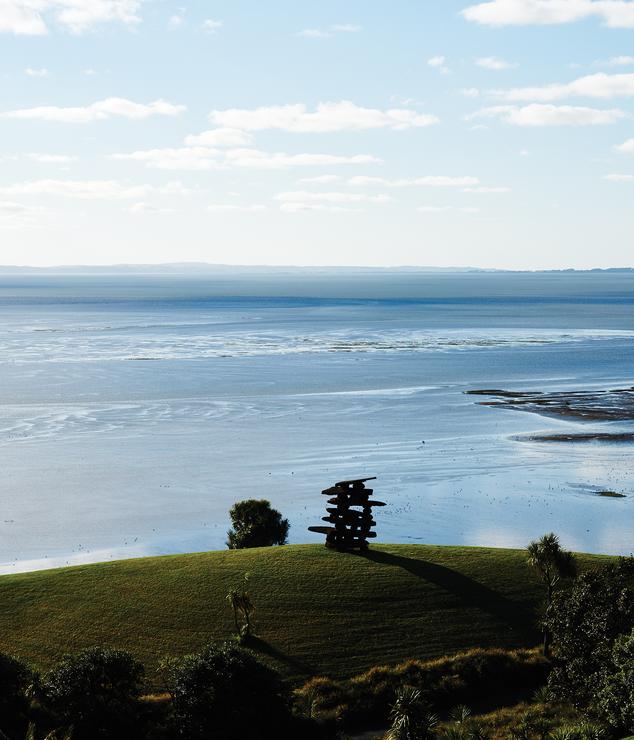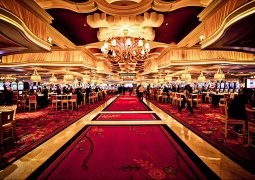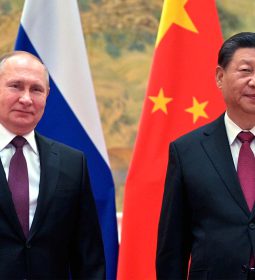A Reclusive Millionaire’s Vast New Zealand Sculpture Park

IT’S HARD TO HIDE this place,” says the art collector Alan Gibbs as he bounces in an open-topped Jeep through his vast contemporary sculpture park in rural New Zealand. “People see things from the road. That’s how it first got known.” Only the site’s isolation has kept it a relative secret within the art world. Everything about its scale is gargantuan.
Across the 1,200-acre park, known simply as Gibbs Farm, the eye is drawn from one enormous coup de théâtre to the next: an 80-foot-high trumpet in lipstick red, towering columns of burnished steel, brilliant stainless-steel tubes that twist in the air like hairpins of the gods. Over the past two decades, this landscape has sprouted works by Richard Serra, Anish Kapoor, Sol LeWitt and Maya Lin, among others.
Gibbs drives up to the most prominent piece: Crowning one of the park’s highest crests are the soaring metal fingers of French artist Bernar Venet’s 2012 sculpture 88.5˚ ARC x 8, whose 88-foot-tall strands have been compared to “golden arcs dancing en pointe” by one critic. A couple of Mongolian yaks stand beneath it, munching idly on the grass. “My yaks like to sharpen their horns on that one,” he says. “You can see the marks.”
The boldness of these colossal artworks matches the grandeur of their natural setting. The Farm, an hour’s drive north of Auckland, sprawls along Kaipara Harbour, the largest estuary in the Southern Hemisphere, which consumes the horizon like an inland sea. It’s a primeval landscape, bathed in crystalline light: The sky here feels eerily close, as if pulled tighter to the earth at this far latitude. The fringes of the Farm bristle with spiky native nikau palms that seem plucked from a Lost in Space episode.
‘‘A beautiful landscape in which artworks are sensitively set creates an elevated experience. nobody is looking at their phones at these places.’’
The park has been sculpted into voluptuous hills dotted with man-made lakes and open lawns of manicured kikuyu grass, resulting in a dreamlike interplay of art and nature. Some sculptures revolve in the wind; others catch the sunlight and burn incandescently at dusk. On the mud flats, a string of 11 Roman-style arches created by Andy Goldsworthy from pink sandstone emerge from the water at low tide like the coils of a sea monster. After dark, video artworks project onto trees and a giant transformer shoots out electricity to create “artificial lightning.” On one man-made lake, a wall of geysers spurts on command from Gibbs’s cellphone. On another, a polished stainless-steel island—Chinese artist Zhan Wang’s Floating Island of Immortals—drifts back and forth, evoking haunting images of Ming Dynasty paintings. Cameras are set up around the park so Gibbs can admire its many moods while traveling.
Adding to this otherworldly atmosphere are exotic animals—yaks, zebras, alpacas, buffalo and emus—wandering among the park’s 30 sculptures. There’s also a special pen with a trio of giraffes, which sometimes freeze in awkward positions when approached. At such times, Gibbs Farm feels less like Storm King, the monumental sculpture park in New York’s Hudson Valley to which it’s often compared, than Dr. Dolittle’s backyard. Plump sheep graze happily across the hillsides, some of them with wool dyed yellow and green. “The person who did that used food coloring,” Gibbs says. “Although it’s beginning to fade now.”
NEW ZEALAND, a lush archipelago better known as a cinematic landscape for hobbits than for its contemporary artists, might seem an improbable place for such a fantastical venture. But Gibbs Farm is the product of changes that have reshaped the international art scene. “Over the past 25 years, there have been so many amazing fortunes built all over the world, and many of the new private collectors are so passionate,” says John P. Stern, the president of Storm King, which was founded by his father and grandfather in 1960. Recent years have seen a surge of interest in the idea of experiencing art in nature (pioneered by U.S. sculptors of the 1960s such as David Smith, Mark di Suvero and Claes Oldenburg), leading to ambitious projects where creativity on a grand scale is possible, including Naoshima in Japan and Inhotim in Brazil, both set up by multimillionaires who became collectors.
“There is a longing to get out of the white walls of traditional museums,” Stern says. “A beautiful landscape, natural but also designed, in which artworks are sensitively set, creates an elevated experience, entirely in the moment. Nobody is looking at their phones at these places. People look up at the sky, the long views, the sculptures, and say, ‘Oh, my God, this is amazing. What’s next?’ ”
‘‘Alan is determined! and He is very persuasive. When he has an idea that it’s possible to do something exemplary, he’s going to do it.’’
As Gibbs Farm put New Zealand on the international art circuit, it also expanded the cultural life of this thinly populated island nation. “Artworks we once had to travel thousands of miles overseas to see can now be experienced here,” says Sir James Wallace, founder of the Wallace Arts Trust, which promotes New Zealand’s contemporary art in Auckland, the country’s largest city, with 1.5 million inhabitants. Admission to the park is free, but it’s open to the public only about 12 days a year, with spots booking up months in advance.
To hear Gibbs tell it, the whole enterprise began in 1991 as a caprice. “I didn’t buy the Farm to make a sculpture park out of it. I bought it as a place to get out of Auckland for the weekend,” he explains as he drives toward his farmhouse residence. “I just wanted to get away somewhere and do ‘boy things.’ ” These boy things include sailing, helicoptering, shooting and driving his collection of vintage military vehicles. The Farm has never had a curator, which is why it so strikingly bears its owner’s personal stamp.
At 77, Gibbs still has the tall, powerful build of a rugby player and the irreverent sense of humor that many New Zealanders cultivate as a national sport. Wearing an olive Western shirt with yellow trim and a cowboy hat, he resembles a gentleman rancher in Montana with a touch of dandyish flair—a Kiwi Ted Turner.
The many facets of this outdoors-loving collector come together in his grand, rustic residence on the Farm, which he refers to cheerfully as his “wood cabin.” Parked in the garage is a Bond-like amphibious car, the four-wheel Aquada, built by his own company (“Richard Branson drove one of those across the English Channel,” he notes). Based in Auckland, Gibbs Amphibians now has 10 high-speed amphibious vehicle prototypes, including large Humdingas being manufactured in Singapore to help with Asian flood rescues and Quadskis, a cross between a quad bike and a jet ski aimed at the leisure market.
As we settle in for lunch on the expansive farmhouse porch, Gibbs adjusts the angle of our table so that the view includes one of his favorite sculptures, George Rickey’s Column of Four Squares Excentric Gyratory III, whose gleaming silver plates swivel in the breeze. He then points out the hidden details of the harbor, including mud flats that have been sculpted into a lattice of channels. He revels in the Farm’s utter isolation. “Nobody sails around here,” he says. “We might get a couple of boats a week passing by. A few duck hunters in the season. Nobody else.” From this vantage, the Farm seems less like a happy accident than a deliberate projection of Gibbs’s personality.
“Alan is determined!” says Kapoor, who worked with him over three years to create his 2009 piece Dismemberment, Site 1. “That’s a word that springs to mind. And he is very persuasive. When he has an idea that it’s possible to do something exemplary, he’s going to do it.”
GIBBS’S CHILDHOOD in 1940s New Zealand, then a sleepy dominion of the waning British Empire, may explain his affinity for remote getaways but did not suggest a career in contemporary art. A descendant of a religious Presbyterian family, his father was a businessman whose ventures included a string of lingerie stores. “Growing up, I had no exposure at all to modern art,” Gibbs says. “My father had a few landscape paintings on the wall and Maori artifacts, but that was it.” His teen years were spent playing sports before he began studying engineering and economics at the University of Canterbury and Victoria University in Wellington, New Zealand’s capital. It wasn’t until 1963—when, at 23, he made the long ocean voyage to Europe for a camping trip with his then wife (and former high school sweetheart), Jenny Gore—that his sensibilities were jolted by a visit to the Museum of Modern Art in Paris.
“We were both very young, and there was a show with fantastic huge lyrical abstractionist paintings,” he recalls of the exhibition of French artist Georges Mathieu. “We were very taken with their scale and vividness. We thought, Wow, this is fun.”
A lifelong taste for abstraction and minimalism was born, although Gibbs did not yet have the funds to indulge it. He had several false starts in business, ranging from the wildly optimistic (trying to manufacture New Zealand’s first domestic car) to the absurd (importing live chickens from Australia, which died of heat exposure on the flight over). He made his first modest fortune in real estate in Sydney in the early 1970s and was soon renowned in the Australasian business world for being impatient and sharp-tongued.
Helping to establish the Chase bank in Auckland led to a second road-to-Damascus moment: A business trip to Manhattan in 1973 left him deeply impressed by the modern art on display at Chase’s headquarters. “That’s what really got me into collecting,” he recalls. “I thought, We should have art in our New Zealand offices. It would show we’ve got a bit of class. But the board said, ‘Good heavens, no. Our shareholders won’t stand for that!’ Oh, bugger it, I thought, I’ll just buy some art myself.
“That was over 40 years ago,” he adds. “I thought, I’ll keep going so long as I am having fun. So far, I’m liking it better and better.”
Gibbs made his first million in 1981, shortly after he turned 40, from corporate takeovers. In the following decade he helped broker the privatization of state-owned companies in New Zealand against strong public opposition, dodging protesters to attend some meetings. He was soon one of the country’s richest individuals and most prominent art patrons, although he balks at being seen as a Medici. “Art was an interest, not an obsession,” he says. “It’s still not.” Gibbs is averse to overthinking his approach to collecting. “Art is not about reason; it’s an emotional response. That’s the nice thing about it. It’s like looking at this view of the harbor—how do you reason about that?”
Gibbs soon gained a mythic status among New Zealanders as an intensely private, almost secretive figure, consumed by ambitious entrepreneurial plans and exotic travel. In 1991, seeking somewhere remote to relax (“I didn’t want to be seen”), he scoured sparsely populated stretches of farmland north of Auckland by helicopter. He had long dismissed Kaipara Harbour as “a dumpy place,” but when he landed at the future Farm, he was taken aback by its grandeur. Despite its enormous size, the harbor is very shallow, so the tide sweeps out for more than a mile. “When the wet sand is exposed at low tide it has a mirrorlike surface, which reflects the clouds,” he says. “A golden sunset makes it glow like a fire.”
The 250-acre farm, available for a bargain NZ$250,000 ($170,000), was run-down, but Gibbs could see its potential. “The land was as rough as guts, all gullies and ridges, with a few pine trees and eucalyptuses,” he recalls. “But the hills were very muscular; you could see the site had drama and presence.”
Gibbs later purchased more of the surrounding acreage. He knocked down most of the invasive trees himself with a vintage armored car (with a working machine gun) he received as a gift on his 50th birthday, and later with a lumbering tank purchased from the New Zealand army. (On one occasion, he says, he took the visiting actor Michael Douglas for a daredevil spin in the tank; afterward, a visibly shaken Douglas joked that he usually favored a stunt double for such jaunts.)
The first site-specific sculpture was commissioned in 1992 from New Zealand artist Chris Booth, who created Kaipara Strata from a stack of flat stones and river boulders, echoing the Farm’s layered waterfront. After divorcing in 1996, Gibbs began to spend more time overseas, living in Detroit and London to be close to his car factories and visiting large-scale contemporary art sites in the United States—Donald Judd’s enclave in Marfa, Texas; Walter De Maria’s The Lightning Field; James Turrell’s Roden Crater; and Storm King. (“America’s full of lunatics like me,” he says with a chuckle.) More ambitious ideas for the Farm began to germinate.
‘My First Experience was Epic…. There are very few places where artists can have their freedom and the ability to work at such a large scale.’
Every summer, Gibbs returned to New Zealand, inviting artists of international stature to work there. His relationship with visiting artists—through which he has become part of the creative process, often going back and forth about a new work’s design and execution—is one of the more striking elements of the Farm’s development. “It’s very interactive,” Gibbs says. Artists will often stay at the Farm for weeks at a time, over a period of several summers, exploring with Gibbs the contours of the property, which he knows intimately. The entire process can take up to five years. “Usually by the third year, they have an idea of what they want to do,” says Gibbs.
The sense of open-ended possibility often spurs the artists to make their largest pieces to date. “The works have to compete with the landscape, so they need to be ambitious,” he says. “They’ll be lost otherwise.”
As the sculptures have grown, so have the practical challenges of constructing them. A former engineering student, Gibbs is very involved, along with his son-in-law, the architect Noel Lane, blurring the lines between artist and collector. “Not many artists have much of an idea about engineering,” he says. “Sometimes they just give us a few squiggles drawn on a piece of paper, and we have to figure out how to build it.”
The most titanic of the Farm’s 30 pieces, Richard Serra’s Te Tuhirangi Contour, commissioned in 1998 and unveiled in 2003, was a turning point for the Farm, elevating it from a millionaire’s folly to a site of international stature. The vast ribbon of steel, which now crowns a hillside like an austere tiara, broke new ground for the artist. Serra, who has said Gibbs told him that he didn’t want anything “wimpy” when he first visited the Farm in 1998, rose to the occasion with a work made from 56 steel plates, each weighing 11 tons. After the enormous shards were rolled at a foundry in Germany, disaster nearly struck: When the 600-odd tons of steel were ready to be shipped, the captain loaded the slabs too high and they fell over, nearly capsizing the boat. Much of the work had to be redone, setting the project back a year.
After the massive jigsaw finally arrived in New Zealand, Gibbs and Lane worked with Serra for months to devise a system allowing it to be erected—a task made more complex by Serra’s wish to have the entire wall angled at 11 degrees from the vertical. The solution was to weld metal plates to the base of each piece, which were then bolted to a concrete bed hidden beneath the earth. A special base was designed to allow each plate to slide slightly, so that the metal mass wouldn’t buckle when expanding in the summer heat.
The result is elegant in its simplicity when seen from a distance and powerful up close: One critic compared its looming presence to “a dam bulging with water.” Gibbs points out that the rusted Serra is shinier near the base, with a line almost like a watermark close to the grass. “That’s where my sheep rub up against the metal,” he says, smiling affectionately. “I rather like that.”
Matching the Serra sculpture in ambition is Kapoor’s Dismemberment, Site 1, a 275-foot-long red tube, whose twin elliptical openings, each 80 feet high, emerge like monstrous horns on both sides of a hilltop. “It was an engineer’s horror story,” Gibbs says.
Kapoor says he’d never heard of Gibbs Farm when he was initially contacted to do a piece in 2006, so he made the first trip to New Zealand warily. “I didn’t want to feel like I was wasting my time,” he says. “But it was clear from the start that Alan was serious.” Kapoor made three visits to the Farm of several weeks each, adjusting his initial concept to engineering and financial realities. To create the final object, swathes of tensioned PVC fabric were stretched between two 45-ton steel pipes to create a “membrane” that is both majestic and sensual. (Kapoor compares it to “the flayed skin of Greek mythological heroes.”)

Instead of placing the work at the crest of a hill, he and Gibbs decided it would be more striking to embed it in the earth. An entire hillside was excavated, a 70-foot-deep concrete base laid and the artwork put into place by cranes. “Alan is not afraid to mess with the landscape,” says Kapoor. “It’s not sacred. He understands what sculpture does. He knows why it needs to fit in the landscape.”
It’s hard to resist touching the finished artwork. “Jump inside if you like,” Gibbs says. “It’s the world’s biggest trampoline.
“Just don’t slide down the other side,” he adds. “The last person who did that broke both her legs. So we don’t encourage that now.”
I hoist myself onto the lip and bounce inside, feeling a wind blast like the exhalation of a giant lung. From the dark interior, elliptical views of the countryside are framed as neatly as Victorian miniatures.
Maya Lin had a dramatic introduction to the Farm in 2010. “My first experience was epic,” she recalls of her arrival during a tempest. “It was a very bleak, tough, windy, stormy few days.” She wandered the site in a pounding rain. (“I was up to my knees in muck.”) She had met one of Gibbs’s daughters at Storm King; later he explained that he had a huge amount of spare earth on hand from a lake he was excavating and invited her to visit. But he gave her no brief. “He just let me really react to the site,” Lin recalls.
She found herself drawn to one of the most ungainly areas of the Farm, a ragged set of former pastures by the mud flats with horrible drainage. (“I lost a set of boots on it.”) She began to envision undulating mounds covering the 11-acre site, each more than 60 feet high. The next morning, she modeled her idea with paper to show Gibbs. After taking topographical lines, Lin created larger models back in her studio in New York, which were digitally scanned for Gibbs’s team to construct from 105,000 cubic meters of earth. There was a major glitch when the folds turned out to be sharper than Lin had expected, requiring a reworking that delayed completion by a year. “Alan didn’t quibble,” Lin says. The final piece, A Fold in the Field, was unveiled in 2013, reshaping a lost section of the Farm into a hypnotic, rhythmic expanse. “There are very few places where artists can have their freedom and the ability to work at such a large scale,” she says. It remains Lin’s largest work.
Perhaps the creation with which Gibbs became most personally involved is Eric Orr’s “lightning machine,” Electrum (for Len Lye), completed in 1998. Fascinated by the idea of generating lightning since he was a student in the 1950s, Gibbs had already funded several scientific studies on the subject before commissioning Orr to create a device. Working with an electrical engineer in San Francisco, Orr built the world’s largest Tesla coil, a transformer that can generate high-voltage current, named after its 19th-century inventor, Nikola Tesla. Resembling a ball of stainless steel raised on a slender column, it can be pumped with 44,000 volts at the flick of a switch. The coil then increases the current exponentially to create an electrical field of 1.7 million volts that eventually shoots out “artificial lightning” with a deafening crack, an effect both awe-inspiring and terrifying.
Not everything is futuristic or coolly abstract at Gibbs Farm. As dark clouds gather, Gibbs pulls his Jeep up to a stone plinth surrounded by a small fence, the grave of a 19th-century Maori chief, Te Hemara Tauhia. Located on a headland, it seems a site-specific sculpture in itself. The grave is thematically paired with an artwork in the water below, a series of rocks that fully emerge only at low tide. Created by New Zealand artist Russell Moses, Kaipara Waka is based on Maori tradition and points north, the direction taken by spirits of the dead on their last voyage.
The conversation turns to the future of the Farm. “My ideas on art are evolving all the time,” Gibbs says. “Now I need to make a push. We’ve been averaging one commission a year, but we’re falling behind. I want to increase the pace.” The Farm’s growing renown hasn’t affected his artistic decisions, he says, and he has no plans to increase visitor access to cater to demand. “It’s not a public park,” he says with a shrug. “It’s not a charity. I’m happy to let people see it, but it’s still primarily a family holiday retreat.” He admits his four children may not agree: “They can do what they like when I’m gone.
“While I’m alive, I’m going to keep on having fun with this place,” he adds. “I’ve never had plans. I’m not going to start making them now!”
- Previous Bangkok Bombing Wounds More Than 20 People
- Next Trump Budget Would Convert Many Overseas Military Grants to Loans
















